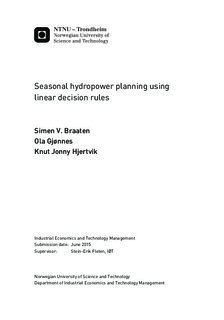Seasonal hydropower planning using linear decision rules
Master thesis
Permanent lenke
http://hdl.handle.net/11250/2352864Utgivelsesdato
2015Metadata
Vis full innførselSamlinger
Sammendrag
Hydroelectric reservoirs need to be managed carefully in order to maximize their benefits. Existing stochastic optimization approaches for making seasonal reservoir schedules often suffer from very high computing efforts, that grow exponentially with the problem size. This thesis investigates a relatively new approach to solve this problem, known as linear decision rules (LDR) approximation. Here, the decision variables are replaced with affine functions of the realizations of the uncertain parameters. The presented LDR optimization model takes uncertainty in price and multiple inflow series into account. Important considerations in hydropower scheduling, such as head corrections and finding water values, are also incorporated. The model is tested to find the applicability of LDR in the seasonal hydropower planning problem, and theoretical upper bounds are obtained to evaluate the quality of the solutions. The main result is that accuracy is traded expensively for tractability, as the solutions from the LDR-formulation are far from the upper bound. The solution values are also clearly beaten by a rolling intrinsic heuristic already in use in the industry. However, reasonable policies and water values are generated, and head corrections are easily included. Additionally, by reducing the number of realizations the decision rules are dependent on, very short computational times are achieved. Therefore, LDR are only a good fit if short running times are important.
